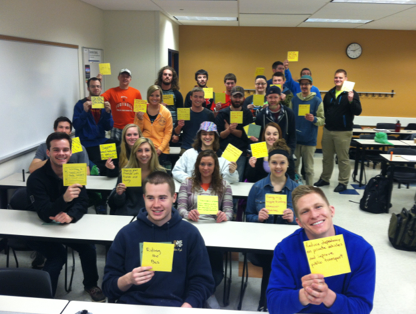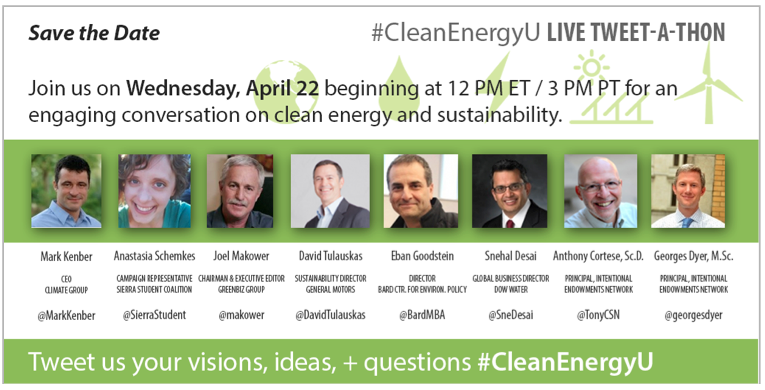Code Green Solutions


How could a #cleanenergyu dialogue, with its Earth Day live tweetathon connecting students, corporations and clean energy leaders, possibly help deliver a 2025 cleaner energy future? Can such multi-stakeholder conversations and partnerships really make a difference?
We continue our #cleanenergyu GBIG series with quieter reflections on how this “goliath that is fossil fuel dependence” can be slain through thoughtful insights from a student’s perspective, Zachary Sompels. Zachary’s class at Grand Valley State University (GVSU) embraced this week’s #cleanenergyu conversation – posting their vision and action aspirations – to discover how they felt the fossil “goliath” could best be slain.
What is perhaps most surprising are the students’ conclusions: yes, they recognized the future as “a diverse landscape (comprising) many smalls solutions to a single large problem” with their own GVSU actions clearly prioritized. But what struck Zachary most from the #cleanenergyu process was the fact that companies like Chevy had joined them “to put a face” on the energy crisis and admit that there is a problem:
“The first step to solving a problem is admitting there is one,” he commented, “Only when the people work and come together, to a realization that our earth is headed toward a serious energy crisis, are we able to unify under this idea of a clean energy future and fight for change.”
So why does Zachary believe that clean energy as a “unifying idea” is the most powerful weapon we have? Which, unlike Goliath, can’t be slain?
And why is he one of the GVSU students who won’t be standing idly by to watch?
Read on… And join us at #cleanenergyu as other campuses, companies and clean energy leaders share insights from their #cleanenergyu conversations this Earth Week to learn what inspired them!
Zachary Sompels:
With today marking the 45th anniversary of Earth Day, Grand Valley State University students have taken a moment to step back and reflect as to why this holiday is important and what it means for the future. The recent collaboration with Chevrolet and other universities has put a face on the otherwise masked assailant in the room- the energy crisis. The fact that large corporations have also come to the realization that we, as citizens of earth, are on the verge on an energy catastrophe is a refreshing idea.
In anticipation of this colossal event, students from Grand Valley State University discussed where they see the clean energy future in 2025. The biggest theme in this discussion was reducing our reliance on fossil fuels. Taking carbon that has been sequestered deep in the earth over millennia and releasing it into the atmosphere in the matter of a few hundred years has altered the natural carbon cycle, resulting in the climate crisis we see today. By reducing our dependence on these fossil fuels, we hope to allow the system to catch itself before it’s too late and to allow for a sustainable energy future for generations to come.
Solar and wind energy implementation have been discussed by students in and out of class, and are idealized as renewable sources to reduce dependence on fossil fuels by 30%, with the addition of recycling, and alternate transportation like walking and biking. What was agreed upon, is that no one answer is feasible for this dynamic problem of reliance on unsustainable energy. In order to combat this issue, we must take a variety of approaches. Only by spreading our energy reduction methods across the map, through solar, wind, water, biking, and recycling, are we able to chip away at the goliath that is fossil fuel dependence. We see the future as a diverse landscape of many small solutions to a single large problem.
In an effort to create a cleaner energy future, we discussed what we are doing now to make a difference. Many of us are already taking steps toward the clean energy future we desire to see ourselves, by utilizing public transportation, using solar panels to charge our phones, monitoring thermostats within our homes and buildings, and paying attention to what can be recycled or composted and what actually is trash. Some of us have even gone as far as consistently writing our local and state leaders in efforts to gain support for a clean energy future. With all these actions, which are undoubtedly helpful, we see the most powerful weapon in our arsenal against unsustainable energy is the spread of information. The idea.
Wind turbines can be torn down, solar panels destroyed, bills turned down, and plastic thrown away, but what can’t be destroyed is a unifying idea. Only when the people work and come together, to a realization that our earth is headed toward a serious energy crisis, are we able to unify under this idea of a clean energy future and fight for change. The first step to solving a problem is admitting there is one. The spread of this knowledge about sustainable systems, the carbon cycle, and where our future is heading is what we need to do this. At Grand Valley State University, students firmly believe that an informed citizen is one who can’t stand idly by and watch. This education of the public is the best tool possible for a clean energy future. Though big changes start with small steps, the real first step is knowing that a change needs to be made. – Zahary Sompels*
Intrigued to learn more about how students see their 2025 clean energy future? And how they think we will best journey there?
Join us again at #cleanenergyu to continue the dialogue as more participants share their insights.
 Note: the opinions written are those of the author and not meant to represent Grand Valley State University or its administration as a whole.
Note: the opinions written are those of the author and not meant to represent Grand Valley State University or its administration as a whole.